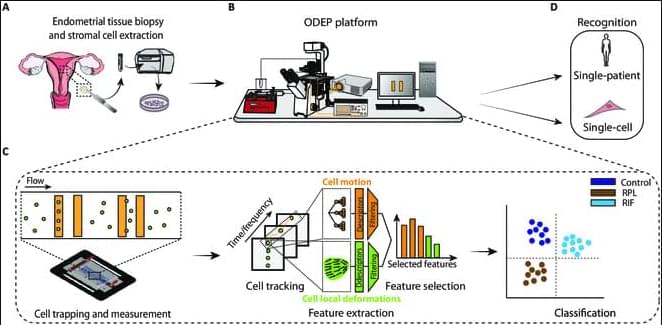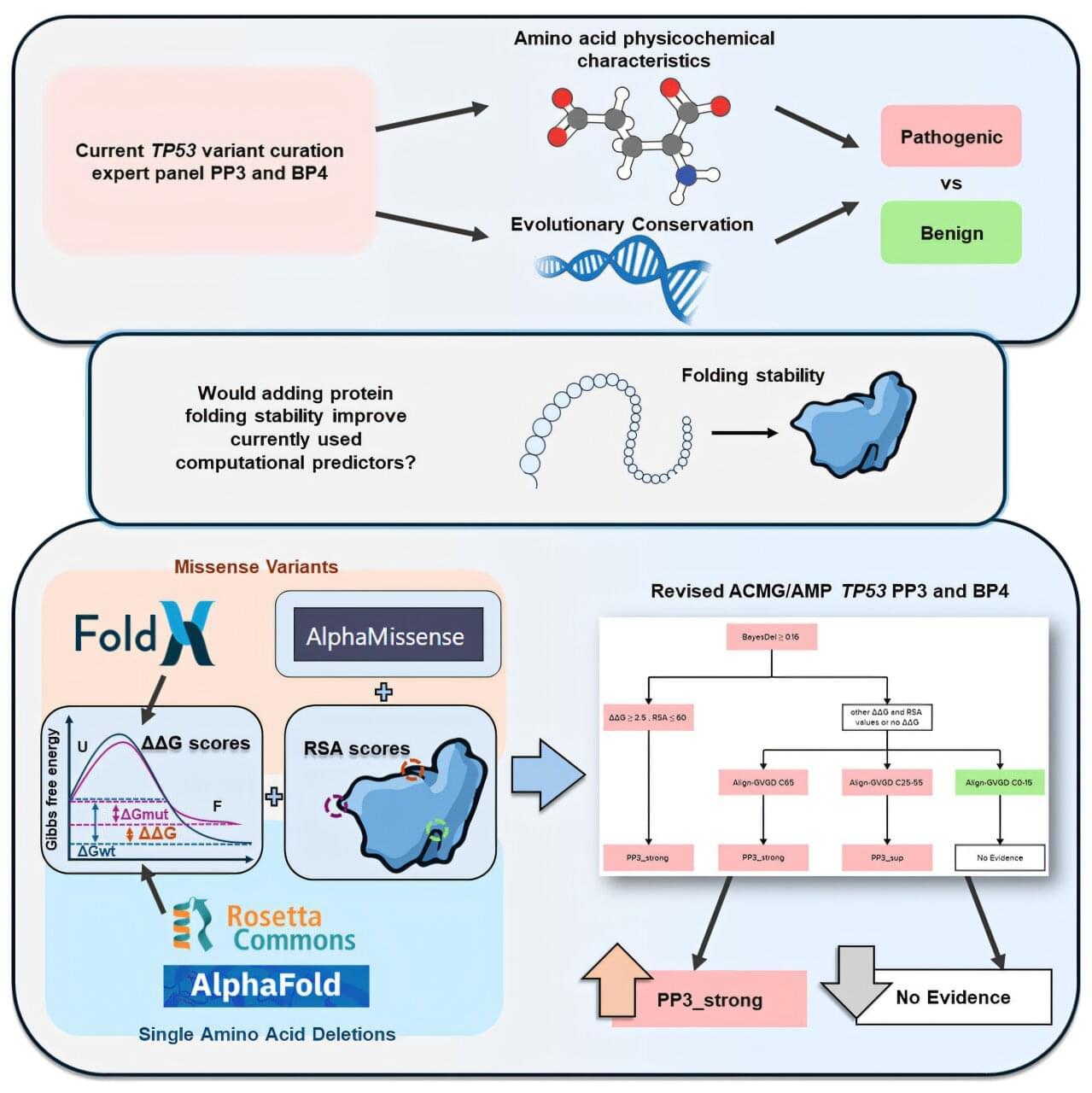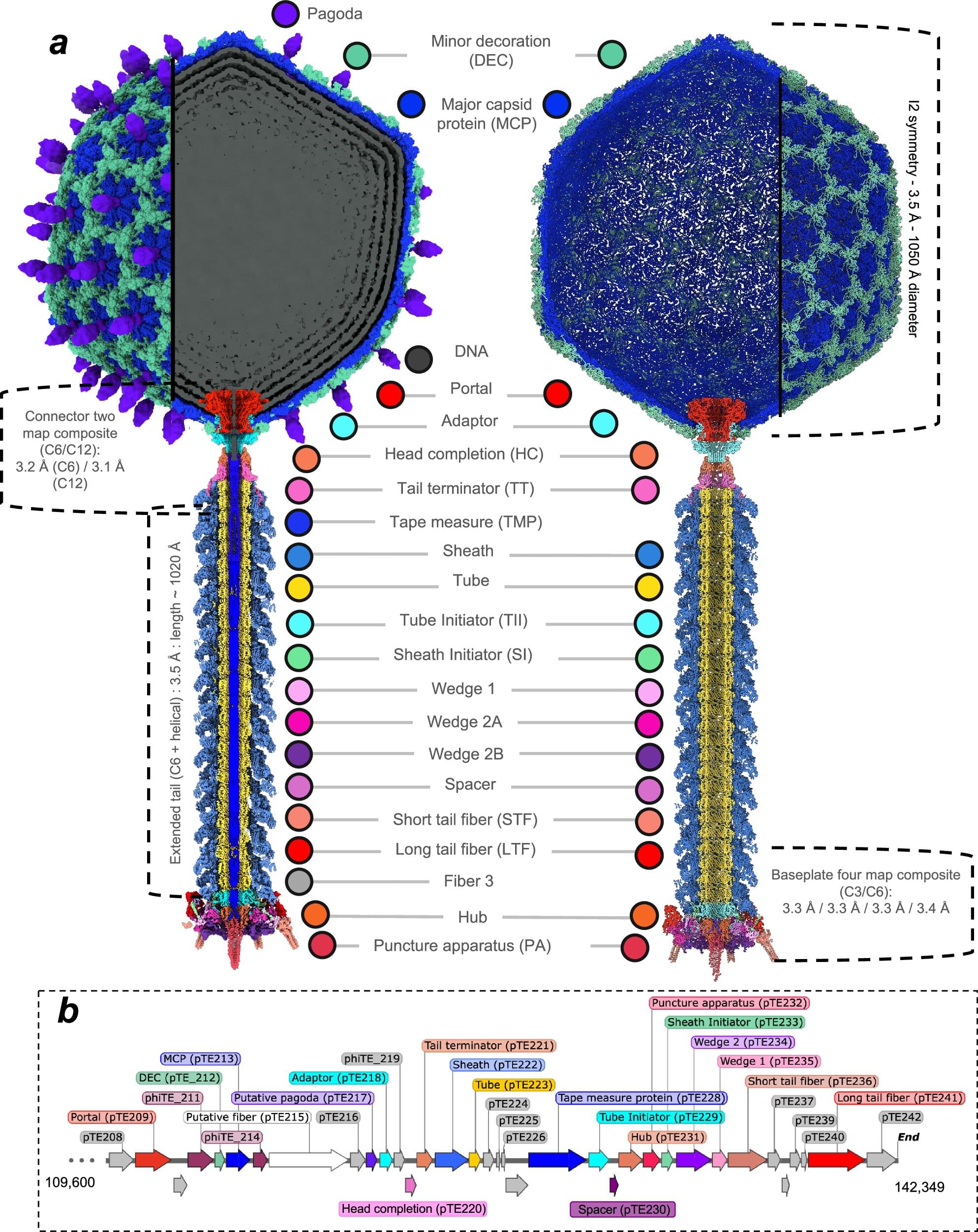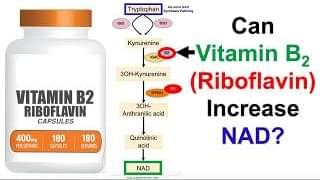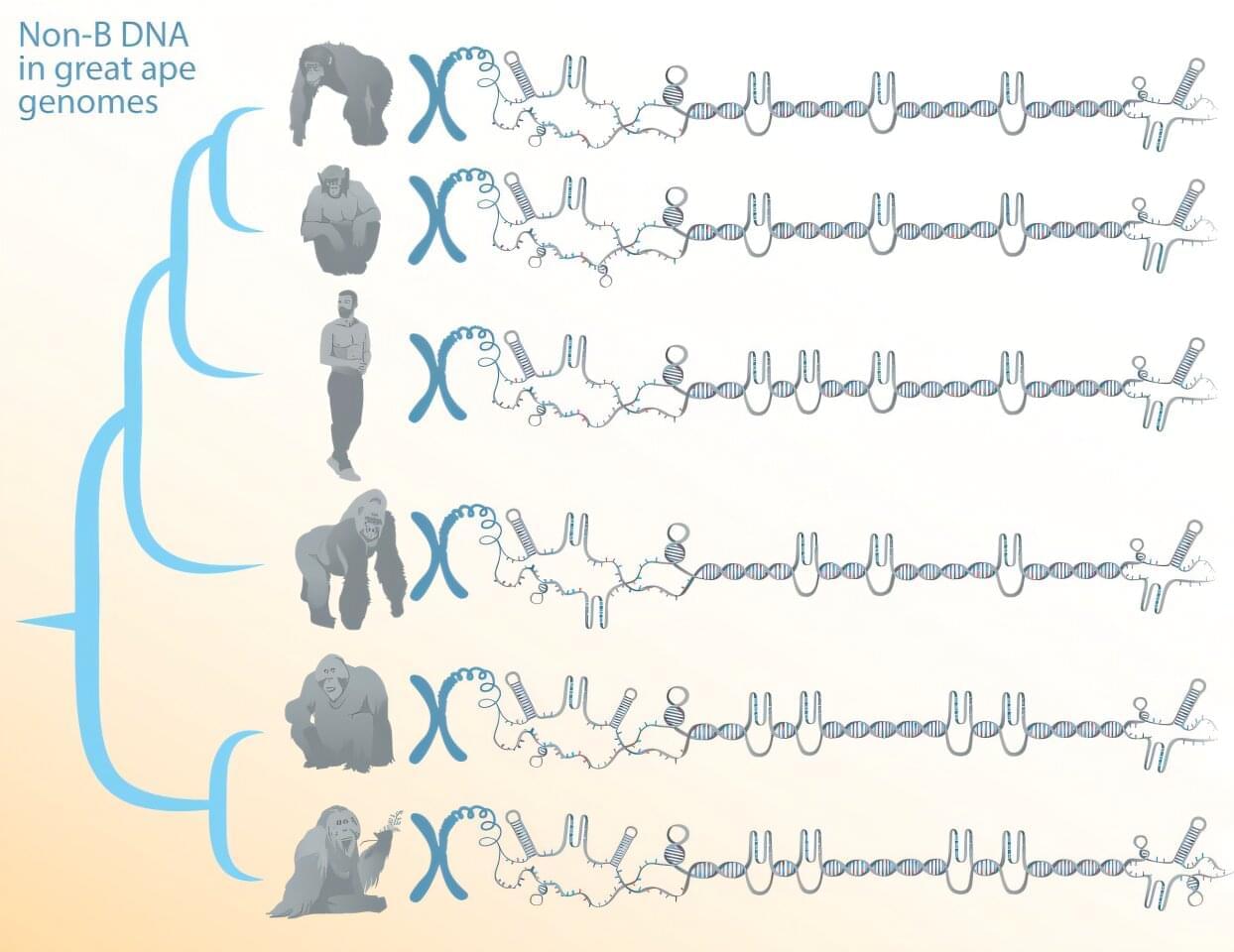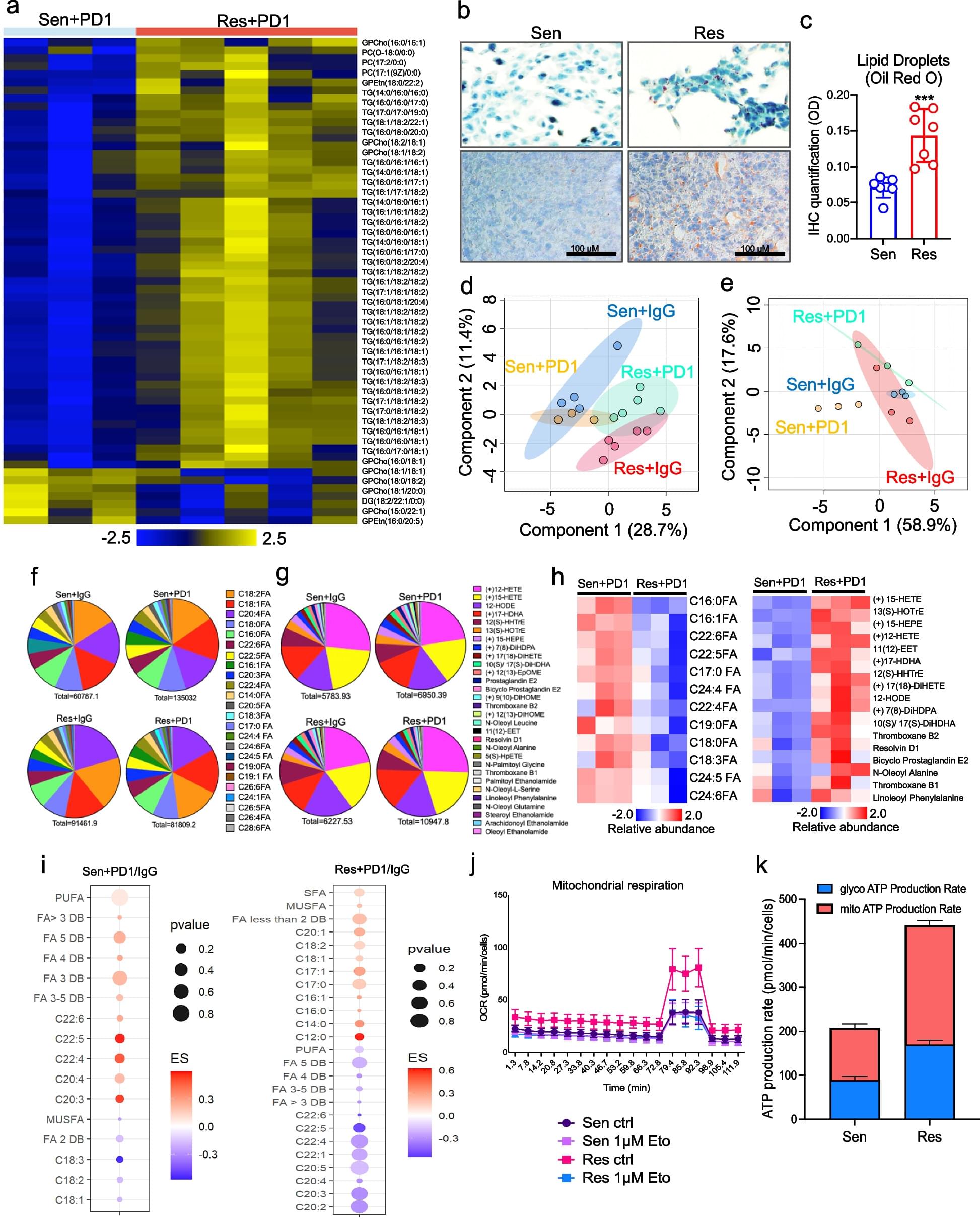The presence of cellular defects of multifactorial nature can be hard to characterize accurately and early due to the complex interplay of genetic, environmental, and lifestyle factors. With this study, by bridging optically-induced dielectrophoresis (ODEP), microfluidics, live-cell imaging, and machine learning, we provide the ground for devising a robotic micromanipulation and analysis system for single-cell phenotyping. Cells under the influence of nonuniform electric fields generated via ODEP can be recorded and measured. The induced responses obtained under time-variant ODEP stimulation reflect the cells’ chemical, morphological, and structural characteristics in an automated, flexible, and label-free manner.
Category: genetics – Page 4
QIMR Berghofer-led research has shown that new advanced computational prediction tools can improve the accuracy of genetic testing for families affected by an inherited condition that significantly increases their risk of developing cancer, paving the way to better targeted care.
The findings have been published in the American Journal of Human Genetics alongside complementary studies by international collaborators, which together show how incorporating the new computational biology tools with existing modeling methods improved the predictive power of genetic test results.
Computational tools are used to predict if and how a genetic variant is likely to impact the function of the protein encoded by the gene.
Plants are susceptible to a wide range of pathogens. For the common potato plant, one such threat is Pectobacterium atrosepticum, a bacterium that causes stems to blacken, tissues to decay, and often leads to plant death, resulting in significant agricultural losses each year.
In 2012, researchers isolated a new virus that infects and kills this bacterium—a bacteriophage named φTE (phiTE). Now, for the first time, scientists have uncovered the atomic structure of φTE, revealing a possible mechanism of infection that may be more complex than previously thought.
The study, published earlier this month in Nature Communications, is the result of a multidisciplinary collaboration between researchers from the Okinawa Institute of Science and Technology (OIST) and the University of Otago. It brings together expertise across several fields, including virology, structural biology, molecular genetics, protein engineering, biochemistry, and biophysics.
Join us on Patreon! https://www.patreon.com/MichaelLustgartenPhD
Discount Links/Affiliates:
Blood testing (where I get the majority of my labs): https://www.ultalabtests.com/partners/michaellustgarten.
At-Home Metabolomics: https://www.iollo.com?ref=michael-lustgarten.
Use Code: CONQUERAGING At Checkout.
Clearly Filtered Water Filter: https://get.aspr.app/SHoPY
Epigenetic, Telomere Testing: https://trudiagnostic.com/?irclickid=U-s3Ii2r7xyIU-LSYLyQdQ6…M0&irgwc=1
Use Code: CONQUERAGING
NAD+ Quantification: https://www.jinfiniti.com/intracellular-nad-test/
Certain DNA sequences can form structures other than the canonical double helix. These alternative DNA conformations—referred to as non-B DNA—have been implicated as regulators of cellular processes and of genome evolution, but their DNA tends to be repetitive, which until recently made reliably reading and assembling their sequences difficult.
Now, a team of researchers, led by Penn State biologists, has comprehensively predicted the location of non-B DNA structures in great apes. It’s the first step in understanding the functions and evolution of such structures, known to contribute to genetic diseases and cancer, the team said.
The work depends on newly available telomere-to-telomere (T2T), or end-to-end, genomes of humans and other great apes that overcame sequencing and assembly difficulties associated with repetitive DNA to fill in any remaining gaps in the genomes. A paper describing the study, which shows that non-B DNA is enriched in the newly sequenced segments of the genomes and suggests potential new functions, was published in the journal Nucleic Acids Research.
Studies by a growing number of labs have identified neurological health benefits from exposing human volunteers or animal models to light, sound and/or tactile stimulation at the brain’s “gamma” frequency rhythm of 40Hz. In the latest such research at The Picower Institute for Learning and Memory and Alana Down Syndrome Center at MIT, scientists found that 40Hz sensory stimulation improved cognition and circuit connectivity and encouraged the growth of new neurons in mice genetically engineered to model Down syndrome.
Li-Huei Tsai, Picower Professor at MIT and senior author of the new study in PLOS ONE, said that the results are encouraging but also cautioned that much more work is needed to test whether the method, called GENUS (for Gamma Entrainment Using Sensory Stimulation), could provide clinical benefits for people with Down syndrome. Her lab has begun a small study with human volunteers at MIT.
“While this work, for the first time, shows the beneficial effects of GENUS on Down syndrome using an imperfect mouse model, we need to be cautious as there is not yet data showing whether this also works in humans,” said Tsai, who directs The Picower Institute and The Alana Center, and is a member of MIT’s Brain and Cognitive Sciences faculty.
Karolinska Institutet researchers report that children born before 34 weeks of gestation show persistent deficits in cognitive abilities at ages 9 to 10. Impairments appear independent of socioeconomic status, genetic predisposition, and prenatal or child-specific risk factors. Lower scores were observed in vocabulary, working memory, episodic memory, and recall tasks. Children born late preterm (34–36 weeks) or early term (37–38 weeks) performed comparably to those born full term.
Preterm birth affects approximately 13 million infants worldwide each year and remains a leading cause of childhood morbidity and mortality. Although advances in perinatal care have increased survival, cognitive deficits in these children continue to present major public health concerns.
Critical brain development processes that occur between 24 and 40 weeks of gestation may be disrupted by premature birth. Prior research has mostly focused on extremely or very preterm infants, often overlooking those born moderately or late preterm, who constitute a large portion of preterm births.
Cancer creates an immunosuppressive environment that hampers immune responses, allowing tumors to grow and resist therapy. One way the immune system fights back is by inducing ferroptosis, a type of cell death, in tumor cells through CD8 + T cells. This involves lipid peroxidation and enzymes like lysophosphatidylcholine acyltransferase 3 (Lpcat3), which makes cells more prone to ferroptosis. However, the mechanisms by which cancer cells avoid immunotherapy-mediated ferroptosis are unclear. Our study reveals how cancer cells evade ferroptosis and anti-tumor immunity through the upregulation of fatty acid-binding protein 7 (Fabp7).
To explore how cancer cells resist immune cell-mediated ferroptosis, we used a comprehensive range of techniques. We worked with cell lines including PD1-sensitive, PD1-resistant, B16F10, and QPP7 glioblastoma cells, and conducted in vivo studies in syngeneic 129 Sv/Ev, C57BL/6, and conditional knockout mice with Rora deletion specifically in CD8+ T cells, Cd8 cre; Rorafl mice. Methods included mass spectrometry-based lipidomics, targeted lipidomics, Oil Red O staining, Seahorse analysis, quantitative PCR, immunohistochemistry, PPARγ transcription factor assays, ChIP-seq, untargeted lipidomic analysis, ROS assay, ex vivo co-culture of CD8+ T cells with cancer cells, ATAC-seq, RNA-seq, Western blotting, co-immunoprecipitation assay, flow cytometry and Imaging Mass Cytometry.
PD1-resistant tumors upregulate Fabp7, driving protective metabolic changes that shield cells from ferroptosis and evade anti-tumor immunity. Fabp7 decreases the transcription of ferroptosis-inducing genes like Lpcat3 and increases the transcription of ferroptosis-protective genes such as Bmal1 through epigenetic reprogramming. Lipidomic profiling revealed that Fabp7 increases triglycerides and monounsaturated fatty acids (MUFAs), which impede lipid peroxidation and ROS generation. Fabp7 also improves mitochondrial function and fatty acid oxidation (FAO), enhancing cancer cell survival. Furthermore, cancer cells increase Fabp7 expression in CD8+ T cells, disrupting circadian clock gene expression and triggering apoptosis through p53 stabilization. Clinical trial data revealed that higher FABP7 expression correlates with poorer overall survival and progression-free survival in patients undergoing immunotherapy.
The first genetically engineered synapses have been implanted in a mammal’s brain. Chemical brain signals have been bypassed in the brains of mice and replaced with electrical signals, changing their behaviour in incredible ways. Not only did they become more sociable, they were also less anxious and exhibited fewer OCD-like symptoms. This work has sparked hope that one day we could use this technology to help humans with mental health conditions. But would you want someone making permanent edits to your brain?
For the first time, climate scientists can now link specific fossil fuel companies to climate-related economic damages in particular places. A new method has been developed that can show the exact impact these companies are having on our environment — which the world’s top five emitters linked to trillions of dollars of economic losses. Find out how scientists have managed to piece this together — and whether these companies are about to face massive lawsuits.
As we reflect on the death of Pope Francis, we explore his legacy on scientific issues and his transformative stance on climate change. As the spiritual leader of 1.4 billion Catholics, he became an influential figure in advocating for better care to be taken of our planet. Will his legacy continue with the next Pope?
Chapters:
00:00 Intro.
00:28 First brain engineering in a mammal.
10:57 Landmark in fossil fuel lawsuits.
19:33 Climate legacy of Pope Francis.
Hosted by Rowan Hooper and Penny Sarchet, with guests Alexandra Thompson, James Dinneen, William Schafer, Chris Callahan, Justin Mankin and Miles Pattenden.
–
Learn more ➤ https://www.newscientist.com/podcasts.
Subscribe ➤ https://bit.ly/NSYTSUBS
A new study found that a gene recently recognized as a biomarker for Alzheimer’s disease is actually a cause of it, due to its previously unknown secondary function. Researchers at the University of California San Diego used artificial intelligence to help both unravel this mystery of Alzheimer’s disease and discover a potential treatment that obstructs the gene’s moonlighting role.
The research team published their results on April 23 in the journal Cell.
About one in nine people aged 65 and older has Alzheimer’s disease, the most common cause of dementia. While some particular genes, when mutated, can lead to Alzheimer’s, that connection only accounts for a small percentage of all Alzheimer’s patients. The vast majority of patients do not have a mutation in a known disease-causing gene; instead, they have “spontaneous” Alzheimer’s, and the causes for that are unclear.
